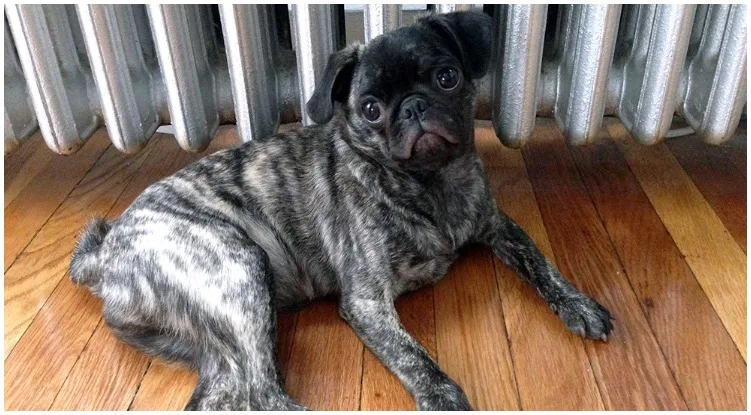Have you heard about the Brindle Pug? Their name refers to the unique coat that these dogs have. While most Pugs are fawn, tan, or sometimes even white, these have a combination of different colors. Brindle Pugs are rare, but definitely worth taking a closer look at. But let us warn you — chances are you’ll fall in love with them instantly.
Brindle Pugs in most cases have brown fur with dark flecks. They are extremely rare, very difficult to find, and not recognized by the AKC. In fact, the brindle pug remains rather mysterious among pug owners.
Brindle Pugs And Other Colors
You should be aware of the fact that Pugs can range in hues from light apricot to dark tan. Up to date, the AKC also recognizes black pugs.
Also, they can come in white and brindle. All of these are still waiting for their recognition from the AKC.
Why was that? It’s because the brindle itself isn’t actually a color, it’s more of a pattern. More specifically, brindle is a pattern of tiger-like stripes that are usually grey and brown.
Like many other pugs, brindles typically have a black mask around the muzzle, a black mark on their forehead (known to us as the “thumbprint”), and a dark line of hair that moves down the pugs back as they age (similar to humans).
Where does the Brindle Pug Come from?
Pugs, and therefore also Brindle Pugs, are originally from China.
With that being said, during the reign of Emperor Chin Shih Huang, all documents of this breed were destroyed as an attempt to keep the breeds secrets. So, that also means that we cannot trace exactly where the brindle in pugs came from but the guess is that’s somewhere around 400 BC.
What we do know, however, is that paintings from the 1700s depict brindle pugs, thereby demonstrating that somewhere in history the genetic line did, in fact, exist and eventually just died out.
Brindle Pugs Temperament
First of all, brindle pugs can be just as purebred as other colors so their temperament doesn’t differ in terms of the breed.
Their personality is a mixture of everything. Sometimes they are outgoing and very playful while other times they are really calm and relaxed.
You should keep in mind and don’t expect the brindle pug to be an excellent guard dog. While these dogs are really good family dogs, they aren’t overly protective or territorial in nature.
They love and enjoy being around people’s company and at the same time they are very friendly to everyone. For this reason, brindle pugs need a lot of love and attention, and will sit on your lap anytime you allow them to do so. They are really friendly to the other pets too.
Taking care of a Brindle Pug
As said in the beginning of this article, Pugs make excellent companions, they also require a lot of care, especially in the way of grooming.
Firstly, pugs have deep folds of skin on their face that need to be cleaned regularly. A pug’s wrinkles can hold onto dirt and debris, becoming easily irritated and even smelly. By preventing this your pup will be thankful.
So, to prevent irritation and keep your pup happy, folds should be cleaned at least once a week. If your dog already suffers from irritation, they should be cleaned 2-3 times per day.
Despite the fact that pugs have short fur, they tend to shed a lot which is unusual for short fur puppies.
In return, they require daily brushing and regular bathing (once per month is enough) to keep down on fur loss. Brindle pugs also require regular nail trims, ear cleanings, and eye cleanings. Sounds complicated? It just sounds, it couldn’t be easier and your pup will in return give you all of his love.
In terms of exercise and food, pugs don’t require a lot in comparison to some other breeds which makes them perfect pups for someone who doesn’t have much time to spend,, but consideration needs to be taken.
Their requirements are about 1 cup of dog food per day (similar to full-grown adults) and approximately 20-30 minutes of exercise twice per day.
Health and Life expectancy
Health wise Pugs aren’t generally a healthy breed. The same therefore goes for white pugs. They are brachycephalic, which means that breathing problems are common. Also, there is an increased risk of eye prolapse.
They are also prone to Encephalitis. This condition is a neurological (brain) disease that is only found in the pug breed. When a pug has Encephalitis, the brain tissues become inflamed resulting in pain, seizures, and eventually death. As every species has their own health issues, also the Pugs have their own.
Other health problems Pugs might have:
- Cheyletiella Dermatitis (Walking Dandruff)
- Pug Dog Encephalitis
- Epilepsy
- Nerve Degeneration
- Corneal Ulcers
- Dry Eye
- Eye Problems
- Allergies
- Demodectic Mange
- Hip Dysplasia
The life expectancy of a White Pug is between 12 and 15 years.

